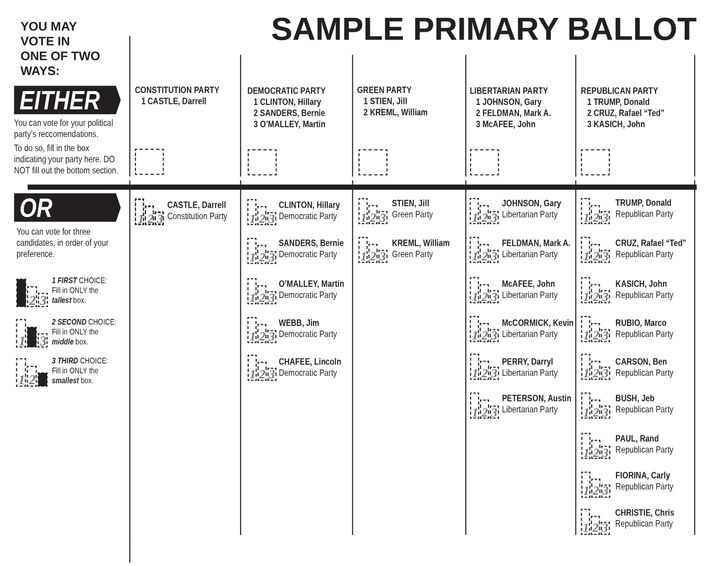Over the past couple of weeks, I have written some blog posts at HuffPo which pretty much boiled down to: “I hate Hillary Clinton, so much, because she’s a cheat.”
Welp, not much I can do about it now.
So for me, this election cycle is over. Now I’m thinking about the next election.
And by that, I don’t mean that we should be thinking about who to nominate or what policies should be on the platform. We should think about the election itself, so that 2020 (and the mid-terms in 2018) don’t end up like 2016: a clusterf―k where the two most hated people in America have turned the Presidential election into nothing more than an unpopularity contest.
And that means fixing our broken primary system.
Right now, primaries are complex, frustrating messes that have resulted in producing candidates who don’t have a good portion of the party’s support.
Early voting states like Iowa and New Hampshire disproportionately set policy for the entire country; votes are manipulated and manhandled both through malice and simple complexity, voters are improperly culled from the rolls, there are tons of ways for party leadership to lean on the scales, and the end result is, well, undemocratic (with a small ‘d’) for everyone.
Implicit in our right as Americans to choose our own elected officials is the right to determine how viable candidates for office are selected.
Every tyrannical state that feigns democracy offers “democracy but…” by controlling who the candidates are and presenting the people with a false dilemma. The Politburo did this in the USSR. China is doing this to Hong Kong for the 2017 elections (sparking the Umbrella Movement in protest,) the Guardian Council does this to Iran.
In America, we have two people controlling who is a viable candidate for office: the parties, and political campaign funders. We must address both.
The funders’ influence can be mitigated by solid statutory reform, and it’s easy to find various model plans to do so. But less obvious is how to deal with the problem of political party kingmakers and “Boss Tweed”-like insiders.
And we must deal with this problem, because right now, those who end up on the losing end of the election don’t feel like we lost fair and square. That means resentment. By shafting the younger generation this year, who knows how many young Democrats will not vote for a Democratic candidate down the ticket this year, or in 2018, or in 2020... or maybe even in their lifetimes. When we know that there were shenanigans in the process, it makes it hard to even consider the Democratic party anything but a con.
To that end we have a simple solution: we take control of the primary process away from the parties, and we ensure a fair system for elections where everyone ultimately has a say in who represents us.
Instead of staggered state primaries, there should be one primary day, managed by the FEC, not the parties. For the sake of convenience and timing, let’s go ahead and make it July 4th. It’s already a holiday, and it gives us about four months before the general election.
On the primary ballot, instead of the party determining “who is and isn’t a member,” all citizens are eligible to vote. All get the same ballot, with all the candidates, from all the parties, listed on it. Voters mark their first preference, second preference, and third preference. They can cross party lines, even on the same ballot. That’s it. They’re done.
From those votes, any candidate with more than 1/3rd of the vote is considered a candidate in the general election. If two candidates don’t beat 1/3rd of the vote, then you start transferring votes to second, and if need be, third preferences, by a process known as “single transferable vote,” or “ranked choice voting.” ― you can check the links if you want more of the dirty details.

By the end of it, you have two candidates who then have four months to make the case that they should get the office, there’s enough voters out there to make the swing meaningful, and most importantly, the system gets just that much less rigged.
Now, of course, there are some advantages to staggered primaries run by the parties. Candidates with no chance can save money and time by dropping out early in the process. Politicians can get practice in a few cheap states before mounting a super-expensive national campaign. There is value to that. So why not split the difference: Political parties can determine (through their own private rules) what order candidates go on the ballot, under the listing for their party. That is, a candidate who has the private support of the members of the party gets listed first in that party’s slot on the ballot. Naturally, though, the order of the parties themselves are randomized.
So there you go. You can vote for who you want. No backroom deals, no convoluted rules, no crazy motions and points of order on the floor. And at the end of it, a general election ballot that’s as simple as it’s always been.
For #NeverHillary and #NeverTrump people in our respective parties… well, we fought the good fight and lost. But that means we have a four month head start on everyone else for next year.
And we can do this, if we start organizing now. If we prepare for demonstrations on Inauguration day and mass protests on Groundhog Day (as suggested by John Oliver), next time, we may not like who our final choices on the ballot are, but at least we can say that we had a fair chance.
I’d like to be able to say that in my lifetime.
